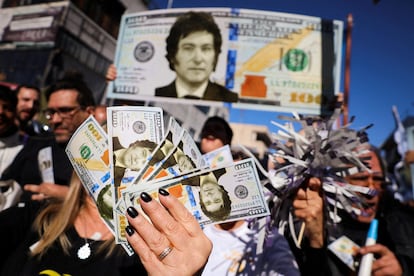Dollarizing the economy: What does it mean and which countries have implemented Javier Milei’s proposal?
Argentina’s president-elect is proposing to use the US dollar as the official currency in order to curb inflation


More than 14 million Argentines voted for 53-year-old Javier Milei as a response to the inflationary crisis ravaging the country. After his recent electoral success against the Peronist candidate Sergio Massa, Milei will assume the presidency of Argentina on Sunday, December 10. His proposals to mitigate the crisis include “dynamiting” the Central Bank, reducing the state’s role to a minimum, slashing social spending and dollarizing the economy.
There are three countries in Latin America that have already adopted the U.S. dollar as their official currency. The first to do so was Panama in 1904. Ecuador followed, replacing its sucre with the dollar in 2000. Then, El Salvador adopted the greenback as its official currency in 2001.
What does ‘dollarizing the economy’ mean?
In economics, ‘dollarization’ implies adopting the U.S. dollar as a country’s official currency. According to the expert Eduardo Levy Yeyati, the U.S. currency is used as a means of payment and exchange, as a currency reserve, as a unit of account and as legal tender. The economist Juan Manuel Telechea says that in order to dollarize the economy in Argentina, the Argentine pesos in circulation must be substituted. “Not only banknotes and cash, but also deposits in banks. All of this must be exchanged for dollars.”
Javier Milei appointed Emilio Ocampo, director of the Center for Economic History Studies at Argentina’s UCEMA university, as the person tasked with drafting and executing the dollarization plan. In his book, Dolarización: Una solución para Argentina (Dollarization: A solution for Argentina), Ocampo proposes two reforms to effectively implement the substitution of the Argentine peso. The first is to adopt the U.S. currency as legal tender. This involves the dollar being declared in Argentina as an official means of exchange for commercial and financial transactions. Citizens and companies would be obliged to accept the currency as payment in order for the peso to be replaced. Ocampo’s second reform proposes that Argentines’ savings stay “beyond the reach of political power.”
“We propose to replace the corporativist, clientelistic and protectionist system that has been in place for over 70 years with an economy that is competitive, open and globally integrated. This kind of system change is not possible if dollarization is not accompanied by other structural and institutional reforms,” says Emilio Ocampo.
According to Juan Manuel Telechea, Milei’s dollarization plan is an “absurdity” that requires at least $30 billion for its execution. “There are not enough dollars to implement dollarization. If someone were to say how many dollars would be needed to dollarize the economy, we are not talking about less than $30 billion. Basically, it is such a high figure that in Argentina’s conditions it seems very difficult to achieve.”
Which countries have dollarized their economies in Latin America?
In Latin America, Ecuador, Panama and El Salvador use the U.S. dollar as legal tender. In the case of Panama, the government declared the dollar as the official currency in 1904, prompted by the construction and operation of the Panama Canal. In the Caribbean country, the dollar coexists alongside the local currency, the balboa, which is used for minor purchases and has a value equivalent to one U.S. dollar.

The economic crisis in Ecuador, which began in 1998, forced President Jamil Mahuad to initiate a complete process of dollarization. The Ecuadorian sucre was replaced by the U.S. dollar in 2000 for financial transactions. It became the only currency in circulation in the country. Mahuad’s government established a fixed exchange rate of 25,000 sucres per dollar, which caused an increase in the prices of products and services.
El Salvador adopted the U.S. dollar as legal tender in 2001, leaving aside the colón, its local currency. Under Nayib Bukele’s government, the Central American country also introduced bitcoin as an official currency. In both countries, dollarization brought a rise in the cost of living and a progressive de-industrialization that resulted in unemployment and forced them to depend on their exports for survival.
How did the Argentine peso-dollar conversion work during the government of Carlos Menem?
Javier Milei’s proposal would not be the first time Argentina has turned to the dollar in an attempt to rescue its economy. In 1991, President Carlos Menem resorted to privatizations and one-to-one convertibility between the Argentine peso and the dollar to curb hyperinflation. Domingo Cavallo, twice minister of economy, was the man tasked with the implementation of the measure. The convertibility, which established a fixed parity between the Argentine peso and the U.S. dollar, was backed by the Central Bank’s reserves. However, this led to the worst economic crisis in Argentina in December 2001.
Twenty years after the corralito (the notorious Argentine bank run), the proposal to dollarize Argentina is back in the public debate with the future investiture of Javier Milei in the government’s Casa Rosada. The proposal was criticized in a letter by Thomas Piketty, Jayati Ghosh and more than 100 economists. “The dollarization seems to offer a solution to Argentina’s chronic inflation problem, and could be tempting when the value of savings and consumption capacity are being devastated by runaway inflation. The current shortage of foreign exchange reserves would make the initial peso-to-dollar conversion rate sufficiently high to generate more inflation.”
According to economists, the Menem government’s convertibility brought an “illusion of stability” that resulted in unemployment and income losses in 2001: “It caused an even greater crisis due to the fiscal and monetary restrictions of the peso-dollar exchange rate peg.” Lastly, they warn that if the dollarization of the economy were to be implemented, the lessons of economic history would be cast aside. Argentina would hand over its monetary sovereignty to the volatility of the U.S. currency and lose its fiscal room for maneuver.
Sign up for our weekly newsletter to get more English-language news coverage from EL PAÍS USA Edition
Tu suscripción se está usando en otro dispositivo
¿Quieres añadir otro usuario a tu suscripción?
Si continúas leyendo en este dispositivo, no se podrá leer en el otro.
FlechaTu suscripción se está usando en otro dispositivo y solo puedes acceder a EL PAÍS desde un dispositivo a la vez.
Si quieres compartir tu cuenta, cambia tu suscripción a la modalidad Premium, así podrás añadir otro usuario. Cada uno accederá con su propia cuenta de email, lo que os permitirá personalizar vuestra experiencia en EL PAÍS.
¿Tienes una suscripción de empresa? Accede aquí para contratar más cuentas.
En el caso de no saber quién está usando tu cuenta, te recomendamos cambiar tu contraseña aquí.
Si decides continuar compartiendo tu cuenta, este mensaje se mostrará en tu dispositivo y en el de la otra persona que está usando tu cuenta de forma indefinida, afectando a tu experiencia de lectura. Puedes consultar aquí los términos y condiciones de la suscripción digital.
More information
Archived In
Últimas noticias
Most viewed
- Oona Chaplin: ‘I told James Cameron that I was living in a treehouse and starting a permaculture project with a friend’
- Sinaloa Cartel war is taking its toll on Los Chapitos
- Reinhard Genzel, Nobel laureate in physics: ‘One-minute videos will never give you the truth’
- Why the price of coffee has skyrocketed: from Brazilian plantations to specialty coffee houses
- Silver prices are going crazy: This is what’s fueling the rally










































